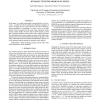Free Online Productivity Tools
i2Speak
i2Symbol
i2OCR
iTex2Img
iWeb2Print
iWeb2Shot
i2Type
iPdf2Split
iPdf2Merge
i2Bopomofo
i2Arabic
i2Style
i2Image
i2PDF
iLatex2Rtf
Sci2ools
ICASSP
2009
IEEE
2009
IEEE
Dynamic texture models of music
In this paper, we consider representing a musical signal as a dynamic texture, a model for both the timbral and rhythmical qualities of sound. We apply the new representation to the task of automatic song segmentation. In particular, we cluster sequences of audio feature-vectors, extracted from the song, using a dynamic texture mixture model (DTM). We show that the DTM model can both detect transition boundaries and accurately cluster coherent segments. The similarities between the dynamic textures which define these segments are based on both timbral and rhythmic qualities of the music, indicating that the DTM model simultaneously captures two of the important aspects required for automatic music analysis.
Related Content
| Added | 21 May 2010 |
| Updated | 21 May 2010 |
| Type | Conference |
| Year | 2009 |
| Where | ICASSP |
| Authors | Luke Barrington, Antoni B. Chan, Gert R. G. Lanckriet |
Comments (0)

